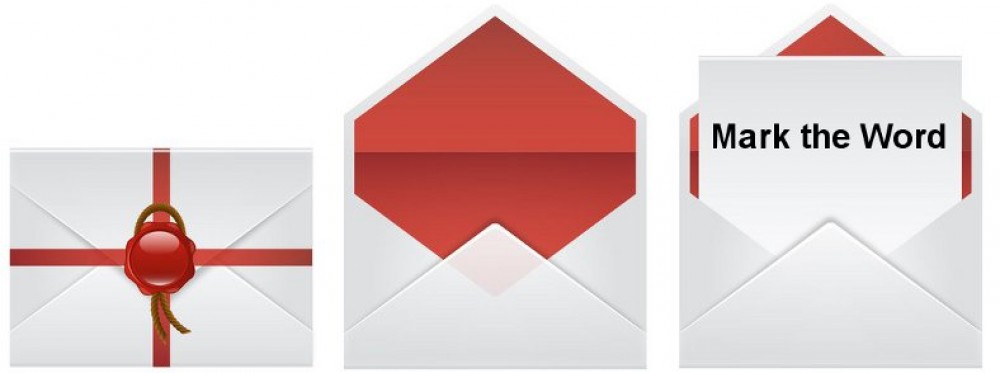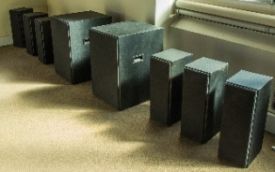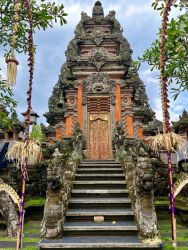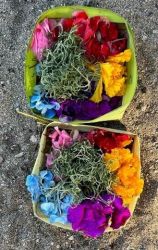Summer 2023
| From the Minister | Welcome to our Summer Edition of Mark the Word. This is the last edition for 2023. The past year seems to have gone by in a whirl aided, we suspect, by the many changes we have had as the Congregation of Mark the Evangelist. We successfully sold our Elm Street property, rehoused ourselves at CTM and are now quite settled in and, over time, we are putting our own touches to the worship space. One of these is the acquisition of our new organ. Peter Blackwood talks more about this, as well as producing a video of the whole installation process. With summer we think of holidays and Robert Gribben’s article addresses the moral aspects of how tourism, and the behaviour of some tourists, can affect the local people of the places we visit, many of whom depend on the income from tourism for a living. On a more sombre note, John Langmore reflects on the escalation of war in the world and the need for more peace initiatives. As always, we have From the Minister, Church Council News and a selection of seasonal music from Donald.
Wishing you all a very blessed Christmas and safe and happy 2024 Vicki and Rosemary We, once again, warmly thank all our contributors who just seem to know when we need articles to fill our newsletter each quarter! Above all, we wish to thank Rod Mummery, the Producer of MtW, who is tirelessly available for advice and expertise 24/7.
From the Minister Once again – it happens every year! – we’re in the season of Advent. We often speak of Advent as a season of “waiting” – waiting perhaps for Christmas (in the shallowest sense) or waiting for God’s promised approach in whatever way that might take place. I’ve been struck this year, however, by the Advent‑ic work of prayer: not a passive waiting but a turning to God in the midst of our struggles, looking to God to heal us of things we can’t heal ourselves. On the world scene, there are plenty of can’t-heals – the Ukraine conflict continues, the Australian post-colonial context, the situation in Gaza may yet get worse before it gets better, and these are just the headlines presently before us, with many other such struggles going on in the background unknown or forgotten. Closer to home and to our hearts are other experiences of hardship, persecution, sadness which are less visible but no less oppressive, and which prove difficult to shake. Our readings this Advent from Isaiah draw a stark contrast between the capacities of God’s people – not great – and the capacities of God – very great. This is not to say that we can’t do anything useful but is say that, in the end, we are not our own and we are not what we do. We are, rather, God’s delight, and God delights to call us from darkness into the light. Let us, then, despite the darkness that so often seems to encroach, ever strive to be people of the light – praying that God’s kingdom come and, in word and action, showing a little of what it will look like when it does. News from Church Council The Congregation’s new digital organ Events of the Congregation The conclusion of the Mark the Evangelist Futures Project Comments, queries and suggestions are welcomed by the Church Councillors: Getting our New Organ to Work
In the Rodgers brochure our organ is described as: ‘having 2 keyboard manuals with drawknobs. Rodgers unique high-resolution sampling process employs up to 8 microphones to record the authentic sound from legendary pipe organs … around the world’.
I have watched a number of pipe organs being built, repaired, renovated, tuned and voiced. I went along to watch and listen to the new digital instrument being voiced and adjusted to suit the Yuma Auditorium of the Centre for Theology and Ministry. Kerry Morenos of Principal Organs is a specialist in preparing Rodgers organs for their performance space. I met Kerry at work going through every stop and note to make them suit our worship space. She was able to let the organ play music by itself from a bank of prerecorded pieces so she could move around the hall listening to the effect from across the space. The organ sang its way through variations on the tune St Denio, ‘Immortal, invisible, God only wise’. Kerry explained that while you could just take the organ out of its box, plug it in and play, the voicing process makes sure that the softest sounds can be heard and the loudest stops don’t rattle the windows. Each stop needs to play with other stops in such a way that they are pleasing to hear. Kerry was keen that the sounds that were mixed together would make Donald Nicolson happy, so Donald joined her in the exacting task of getting the best music for our worship. She also demonstrated how the organ can play one of 300 hymn tunes. I asked for the Old 100th ‘All people that on earth do dwell’. It played an introduction, then, while it played a verse, Kerry changed it from a major key to a minor key. She changed the volume, speed and the pitch and added a few stops to show off how much control can be added. That was probably the last time the automatic hymn feature will be heard from this organ. An exciting feature of the organ is that it can be made to sound like many different pipe organs from around the world. How can this be? Many electronic keyboards make their sounds by adjusting and shaping electronic signals. That is what synthesisers do. In a digital instrument the sounds are recorded samples from real acoustic instruments. In the case of our organ, the hundreds of available voices have been sampled from pipe organs across America, Germany, France and the United Kingdom. It is as if organs from different countries speak with different accents. The German sound will best suit Bach and Buxtehude. A French organ will help the more reflective music of Fauré and Franck. The whole installation of our new organ took place over four days, one for delivery, one for wiring the speakers and two for voicing. At last it was ready for helping lead worship and give recitals. Video made by Peter during the installation On being tourists – and Christian Susan and I spent ten days recently on Bali, an important time of quiet recovery from winter’s ills. The decision to go was not simple. Australia’s story with Bali, and vice versa, is not a happy one. Our minder/driver there, Nyoman, said that he was actually afraid of young drunken Australian tourists. He appreciated others who respected local custom, religious sensitivities, sacred places and who showed an interest in the culture – Bali is unique in Southeast Asia in its dominant local form of Hinduism. Of course, the Big Question was: should we go at all? I remember reading as a student and SCM-er, New Zealand’s late Alan Brash’s articles about the corrupting influences of international tourism – then in its infancy. The issues are even more stark now, as the number of articles on the economic, ecological and other impacts of modern tourism on the internet demonstrates. My own carbon footprint is huge, thanks to my years as an ecumenical officer for the World Methodist Council when I visited churches on every continent except Antarctica. My privilege was that I was in each place as guest and indeed as a Methodist ‘brother’ (a very special status); despite all human differences, we recognized our unity in Christ. When at the Last Judgement I am faced with these charges, I hope my ministry will weigh on the other side of the balance (an inadequate image!). Anyway, we sinned boldly and went. Our ten days were spent in two locations, one near the sea and a (relatively) quiet beach at Sanur and the other, at the top of a deep ravine at the confluence of two rivers in the thin ribbon of jungle left at Ubud, with surrounding rice-fields. For the first days, we both slept, discovering how exhausted we were – and both recovering from nasty ‘colds’. We enjoyed Balinese food (and western food in Balinese style). My intake of fruit went through the roof. At Sanur, we spent a day out on the lagoon in a glass-bottomed boat and at a turtle farm (with caged birds and animals, alas). In the sky there were locally made kites soaring in the blue. We visited a collection of a Belgian-born artist Adrian Le Mayeur (1880-1958), whose European skills were combined with an appreciation of the Balinese people and their own art. The pity of it all was the depredations of the tropical climate on canvas, paper and painting. After these quieter days, we had a bit more energy. Nyoman took us to a village theatre to see a classic dance, the Barong, originating in Ubud and based on a well-known morality tale – which perfectly expressed the eternal battle of Good and Evil, with neither side winning (and so the Circle of life continues). The costumes were brilliant, the dancing agile, and the popular jokes funny. We had no sense that this precious culture was exploited – yet who among the visitors understood the story, let alone compared it with the one they lived by? More crass was the batik-manufactory with its brief introduction to the art and its vast array of products for purchase. Truly precious skills and gifts were turned into relatively cheap -trinkets likely to appeal to strangers (try beach shirts), yet alongside these were exquisite hand-printed and loom-woven fabric for sarongs and scarves – which were extremely expensive. At Ubud we visited a different art collection each day and were rewarded by seeing two modern galleries where the art was in excellent condition. The work – from breathtaking examples of carved local wood to contemporary oil painting – could find its place in any exhibition in the west. The interesting thing to me was that it was expatriate European artists, like Mayeur and the Dutch-born Arie Smit (1916-2016), who had opened the eyes of both Balinese and visitors to the heritage which was ‘hidden’ in the island. They consciously shared their skills with artists and schoolchildren, encouraging them to use new materials and fresh approaches especially to landscape. There are parallels at home in the inspiration of the schoolteacher who invented ‘dot art’ in the 1970s, transforming Indigenous art.
Hinduism in its unique Balinese form (close to basic animism) is the majority religion (87%) and is everywhere evident in small offerings of flowers and food on every level surface. The rest of Indonesia is, of course Muslim, and there are mosques and an Islamic presence (only 10%) on Bali. There is one Buddhist temple, but many local shrines. There is an assumption of mutual respect and there is much real harmony during local festivals. ‘Christianity’, said Nyoman, ’is only found in the city, in Denpasar’. The majority is Roman Catholic (he had some humbling ideas of what Protestants believe – basically, that anything goes in faith and morals). Pentecostalism and evangelical ‘new’ churches are present, including two from Hillsong, some English-speaking. There is a Protestant Church (GKPB) formed by the Dutch Reformed Church in the 1950s, a member of the World Council of Churches. We were nowhere near any of these. So, what to do with our two Sundays? We are eucharistic Christians, but communion was not possible, so we could only enjoy the simple beauty of the land of the people – and be thankful. The only time we saw a cross was chalked on a wall, which Nyoman identified as a form of the swastika, the ancient Vedic sign of auspiciousness and good fortune; written in reverse, it also symbolizes darkness: Christians read the cross both as death and life (but differently!). The signs of Christ’s presence in our Australian society are diminishing too as churches close and our buildings ‘re-purposed‘. Our visit reminded us of the blessings Christians receive from each other’s presence in our landscape – even in the context of increasing opposition, rejection, and ignorance of what we stand for. It’s another call for us to be able to ‘give an account of the hope within us’ (1 Peter 3:15) and draw strength from all that unites us. Towards a New Agenda for Peace We are living in lamentable, violent times. The world is experiencing the highest number of war-like conflicts since 1945, over 50 a year. We are daily reminded of the horrors of war between Hamas and Israel, and Russia’s savage invasion of Ukraine. The destructive impacts of these conflicts are immense. Their interconnected geo-political nature threatens further cascades of violence. The consequences of escalating violence include not only the killing and injuring of multiplying numbers of civilians as well as soldiers, but also terrible destruction of the services essential for wellbeing. This increases fear, anxiety and insecurity everywhere, to which most countries – including Australia – are responding by further military expansion. The resulting arms race intensifies conflict. Increasing military spending feeds the motivation to use the weapons. Militarisation multiplies the danger of war. The necessity for expanded diplomacy has been forgotten. In Australia the proportion of total Commonwealth expenditure for diplomacy has been halved since 1995. Australian diplomacy was allocated about 0.4% of total Commonwealth spending in 1995-96. By 2021-22 this had fallen to 0.2%. The proportion of total national expenditure on diplomacy had been halved during the last quarter century. This means that there was no growth in the numbers of diplomats able to undertake the dialogue and encourage the commitment to human-rights which are essential for reducing international conflict. Australia had a smaller proportion of diplomats and fewer diplomatic posts than all but one of the G20 countries. The new Government has tentatively begun to slightly expand the number of diplomats, but funding continues to be utterly inadequate. If Australia wants to be represented wherever this is relevant, and to have sufficient diplomats to listen to all the countries with which we want to live peacefully, we must expand our diplomatic service. If we want our Government to hear and understand the causes of conflict, we must expand our professional diplomatic service so that they have time to listen, understand and report what is going on and what could be done. The funding for the diplomatic service and support for the United Nations should be at doubled. If Australia declines to do this, we are evading responsibility for peacebuilding. We must also seek ways of supporting our neighbours in their struggles for equitable and environmentally responsible development. We must aim to contribute to reducing conflict everywhere, through our education systems, through our aid programs, through supporting food growing, expanding health services, improving infrastructure, reducing greenhouse emissions, strengthening human rights, all of which would assist with reducing resentment and easing tension. Wealthy Australia now has one of the meanest development aid programs in the western world: about 0.2 per cent of national income. We must rapidly expand our assistance to poor countries so that they can more effectively tackle extreme poverty, ill-health, and over -heating, therefore reducing major causes of frustration, anxiety, hatred, and division. The UN Sustainable Development Goals set out a framework for action and detailed programs. These SDGs were negotiated and adopted by all the countries through the UN General Assembly. They are vital to reducing the vast inequalities of income and wealth and so to increasing social justice, which is essential for reducing conflict. These policies would be directly in Australia’s national interest by reducing the resentments which lead to conflict. They could be entirely paid for by stopping the wasteful explosion in Australian military spending which is underway. Such a transformation would also reduce the growing perception of Australian aggression. Australian military strategy should be focused on protecting our own borders rather than joining in far flung superpower conflict. A wise Australian national security strategy would concentrate on aiming to reduce conflict and supporting improving the wellbeing our neighbours. This would be loving our neighbours as ourselves. Justice and peace for all around us are the most effective ways of strengthening security. |

 The congregation of Mark the Evangelist has purchased a slightly used digital organ. It is a Rodgers Infinity Series 243 that had a short life as a concert instrument in Sydney. It is now installed in the Yuma Auditorium.
The congregation of Mark the Evangelist has purchased a slightly used digital organ. It is a Rodgers Infinity Series 243 that had a short life as a concert instrument in Sydney. It is now installed in the Yuma Auditorium. The list of specifications tells us the organ has 43 stops that deliver a total of 322 voices. The sound comes through eight speaker cabinets up in the gallery. These contain four woofer cones for the bass sounds, twelve midrange cones and six tweeters for high notes. This enables the instrument to sound as if its music is coming from a real pipe organ.
The list of specifications tells us the organ has 43 stops that deliver a total of 322 voices. The sound comes through eight speaker cabinets up in the gallery. These contain four woofer cones for the bass sounds, twelve midrange cones and six tweeters for high notes. This enables the instrument to sound as if its music is coming from a real pipe organ. My guess is that two-thirds of all Bali’s streets are occupied by temples, large and small; the gaps are filled with places to eat and places to buy, everything from chic to kitsch. There are temples and shrines for communities, for businesses, and for families, some very elaborate. Each temple has an ornate main door (left, Pura Saraswati, Ubud), firmly closed to strangers, to those whose eyes could not ‘see’ the sacred treasures within. After a while, we began to recognize what kind of carved stone figure might be on either side of that door, and what characters from the ancient tales of the Ramayana and Mahabharata might be depicted. Nyoman privately took us to a village temple (18th C) where we were allowed to wander freely inside the walls, and where we could ask our questions. Perhaps the most offensive scenario the tourists regularly exhibited was a semi-naked western body being photographed in front of those holy doors, or beside the carved gods and ancient figures – often in mock-oriental postures of prayer or of yoga. Their behaviour was truly blasphemous. Of course, Christians places of worship and prayer are similarly exploited in Europe and the Middle East by liberated westerners. Semi-naked tourists in cathedrals are no more acceptable but tourists (as distinct from pilgrims) claim their ‘right’ to enter.
My guess is that two-thirds of all Bali’s streets are occupied by temples, large and small; the gaps are filled with places to eat and places to buy, everything from chic to kitsch. There are temples and shrines for communities, for businesses, and for families, some very elaborate. Each temple has an ornate main door (left, Pura Saraswati, Ubud), firmly closed to strangers, to those whose eyes could not ‘see’ the sacred treasures within. After a while, we began to recognize what kind of carved stone figure might be on either side of that door, and what characters from the ancient tales of the Ramayana and Mahabharata might be depicted. Nyoman privately took us to a village temple (18th C) where we were allowed to wander freely inside the walls, and where we could ask our questions. Perhaps the most offensive scenario the tourists regularly exhibited was a semi-naked western body being photographed in front of those holy doors, or beside the carved gods and ancient figures – often in mock-oriental postures of prayer or of yoga. Their behaviour was truly blasphemous. Of course, Christians places of worship and prayer are similarly exploited in Europe and the Middle East by liberated westerners. Semi-naked tourists in cathedrals are no more acceptable but tourists (as distinct from pilgrims) claim their ‘right’ to enter.